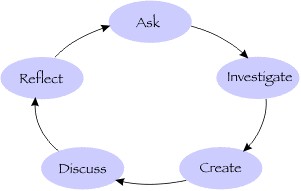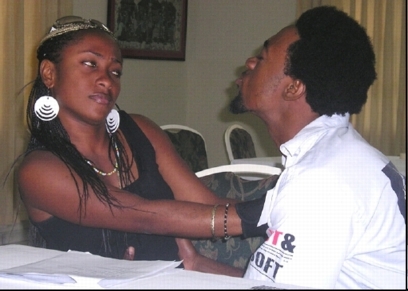Discussion:
Artists occupy a unique role in society. Through a diversity of approaches, they explore new terrains that words alone are incapable of describing. Art can address issues, help solve problems and even serve as a "public psychiatrist" that surfaces social anxieties. Art speaks to places that other languages can't and affects consciousness on a level that we don't understand and can't map. Some, but not all, artists work for social and environmental justice. Notably artists can explore ideas of personal or societal importance or they can operate within a world circumscribed by religious authorities, corporations or the art-buying public, a decidedly privileged class economically.
The "world" that "resistance" strives to understand and confront provides an exhaustible fount of inspiration for artists – professionals and non-professionals alike. The media through which messages and stories can be conveyed includes T-shirts (indeed, wearing the wrong t-shirt is an invitation to harassment, fines, and imprisonment in my regions and countries around the world) and comics and zines, opera, ballet, graffiti, murals, sculpture, film, film or many other approaches. Art can be immersive and engaging; it can help build community and involve the "audience" in rituals or processions. Art can be an invidual or collective effort, big or small, public or anonymous, clandestine and furtive, In can be created by children or by people or emotionally disturbed. The art of homeless people, refugees, or incarcerated people is likely to present a view of the world that the rest of us may not see.
Resistance art brings hidden knowledge out of the shadows. The historic roots of contemporary experience, a common theme of Chicano murals, such as those created by Los Cybrids collective, in Los Angeles and other southwestern cities in the US explore themes of identity and hybridity. Another approach is to present the reality of a situation in a documentary style, such as Walker Evans' sparse, unadorned depression era photographs of the rural poor. Another approach is exemplified by George Grosz's grotesque and piercing caricatures of militarists and war-profiteers, or Hitler garbed in a bearskin.
In the 1980s, Artists of the World Against Apartheid based in France issued a broad appeal to artists around the world to contribute anti-apartheid works of art. Ernest Pignon-Ernest of France and Antonio Saura of Spain worked unselfishly for two years to make it happen. A major exhibition was mounted in late 1983 at the Fondation Nationale des Arts Graphiques et Plastiques in Paris. Since the organizers had stipulated in advance that the art would be held in trust and given to the people of South Africa on the occasion of "the first free and democratic government by universal suffrage" as the basis of an anti-apartheid museum, the collection was moved to South Africa at the request of president Nelson Mandela.
A similar event took place in the U.S. two decades later. With the invasion of Iraq looming, first lady Laura Bush, picked an inopportune time to invite poet Sam Hamill to a special White House event, "Poetry and the American Voice," which was to celebrate the works of Emily Dickinson, Walt Whitman and Langston Hughes. Instead of being seduced by to the allure of power and prestige, Hamill refused Bush's invitation. Instead he emailed several friends asking them for poems on the theme of war which would be bound and presented to Bush. This ignited a poetic firestorm that claimed no national border. Inspired by Hamill's defiance, a web site (http://www.poetsagainstthewar.org) was established that provided a platform for poets around the world to express their feelings related to the impending war. The site proved immediately and enormously popular – at its peak it was averaging several new poems a minute. Now the site has over 20,000 poems online – including works by Adrienne Rich, W.S. Merwin. and Lawrence Ferlinghetti, and spotlights several poems per week. The project ultimately published two volumes of poetry and an excellent documentary film, "Poets in Wartime," was inspired by the effort. Moreover, the work engendered a non-profit organization, "Poets Against War", was formed with the simple yet direct mission statement: "Poets Against War continues the tradition of socially engaged poetry by creating venues for poetry as a voice against war, tyranny and oppression."
This episode (Poets Against War) raises the general question of the role of occupational groups and whether there is an implicit or explicit obligation to help deter aggression and war. A short list of such candidates would include teachers, religious leaders, engineers, journalists, farmers, and doctors and nurses and other caregivers. A longer list would include almost everybody – for very few people in the world actually want to be within war's lethal compass, as either participant or as innocent bystander.
Another fascinating example, is the beehive design collective, an amazing anarchic and itinerant design collective that, although home-based in Vermont, travels around the world to create region-specific murals. Members often work with indigenous or other people to develop murals that capture the unique circumstances of the people who live there. The murals they develop grow organically; containing a variety of elements sinuously weaving indigenous plans and animals, historic referents, and symbols of corporate and colonial domination, with images of fanciful and realistic resistance.
Resistance art has many audiences. In the anti-apartheid movement, for example, the audience would obviously include the victims of apartheid and the supporters of their struggle. It would also include the people who believe themselves neutral of hadn't thought about apartheid from a moral standpoint and people who were actively promulgating it: politicians, policemen, the media, and business spokespeople who benefited from the cheap labor provided by the marginalized victims. Beyond that, the audience extended to the rest of the world. Many people outside of South Africa worked on anti-apartheid campaigns. Gill Scott-Heron's anti-apartheid anthem, "Johannesburg," was played on the radio in US cities, where its uncomfortable references to big segregated cities in the US like New York and Philadelphia showed that South Africa was not the only country in the world where prejudice and racism flourished.
From Goya and Picasso to Johannesburg's T-shirt artists of and anonymous graffiti artists around the world, resistance artists, generally acting on their own – have portrayed the horrors of war or other abominations. Activists in Seattle, hoping to help cultivate a supportive community network for resistance artists have convened an Arts of Resistance conference for the past two years. Through workshops, presentations, videos, and, most importantly, through face-to-face dialogue and debate, the idea that art can be socially transformative became more widely recognized and more thoughtfully practiced.
People ultimately also need to be reminded of two things – that they are not impotent and disconnected spectators but active and engaged participants in the ongoing vibrant fabric of life. Art, therefore, can tell the story of the ongoing struggle while suggesting ways for people to take part. It can also sketch out, in possibly indistinct and uncertain terms, a future that may exist, after successful struggles, where children, and their children, and their children's children do not experience the daily injury of living in an unjust and unhealthy world.
Anglican Bishop Desmond Tutu, a longtime foe of apartheid, notes that when resistance art is successful, "People come to the forceful realization that they are not entirely the impotent playthings of powerful forces." According to Tutu, resistance art, whether it's a play, song or T-shirt represents, "a proud defiance of the hostile forces that would demean and dehumanize."













